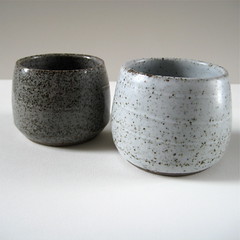This is my very first post on my new blog, which means I must be talking to myself. With no one listening I can say whatever I like I suppose. So just this once I will waffle with impunity.
What are you doing writing a blog? You're supposed to be painting and/or making pots.
I did however make some buttons this morning which are drying in the studio. They're taking a while to dry today. It seems October has properly arrived: overcast and a little damp - and quiet too for a Saturday.
Right, so what's this blog for exactly? Well, at the risk of sounding supercilious, I used to keep an art journal. I even wrote it with a proper quill pen and ink in a special little Tibetan notebook made from recycled pulp - until I wore the nib out on the uneven pages and had to resort to using an old biro. I kept up writing it for about three years (on-and-off) as a reminder of what I was making and the methods used. And for all the pomp and ceremony it was actually a little bit useful because it reminded me of what I was supposed to be doing and (more importantly) how I was supposed to be doing it. So perhaps I'm continuing that same journal in another form...
Actually I admit, I don't really have a clear plan for this blog and I'm not going to make any bold claims or mission statements. So at the moment it's simply here if I want to add things - thoughts, photos, ideas, methodology, waffle. See how things go. What I do know is that this blog will be mostly about pots (and all things ceramic) and paint (and all things 'arty'). After all, these are my primary obsessions - or at least two of them.
So I'd better post this 'very first post' to see if it works.











